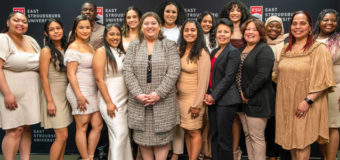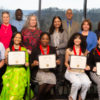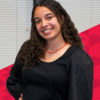Lessons in the Arctic Circle

Posted by: admin on July 28, 2009, No Comments
Eight miles north of the Arctic Circle, a group of East Stroudsburg University students discovered the environmental and cultural challenges of teaching in an isolated Native American community.
Nine students spent 10 days in northeastern Alaska, three days of which were dedicated to interviewing teachers, former students and villagers at the Fort Yukon School. The goal was to find out what it takes for a teacher to succeed in such a remote and culturally different spot. The cross-cultural exchange trip was led last summer by Doug Lare and Rod Weston of ESU’s Professional and Secondary Education Department.
“A lot of the older members of the community grew up in segregated schools. Native students were sometimes beaten for speaking their language. It would impact the students’ belief system and heritage, and this has only recently begun to change,” said Weston, who taught in the Yukon Flats School District for six years.
The school, located in a tiny village of about 600 people, has 125 students, most of them from native American families. Weston, who had taught at the Fort Yukon School, noted the population had been very isolated in the Yukon region of Alaska in the past because of a lack of technology. “They didn’t have their first telephones until 1980,” he said.
“But now it’s progressed, from shortwave radio to the Internet,” added Lare. “Now we can have a video conference with Fort Yukon.”
The ESU group explored the difficulties faced by outsiders hired to teach in such a community, with the goal of determining what made some teachers more successful there than others.
“There are a lot of challenges specific to Alaska,” said Christopher Hipp, an undergraduate social studies student who took part in the exchange. “It can get down to -60°F at night, and then there are long periods of total darkness.”
Added to the physical isolation are cultural barriers that many from outside the community have been unable to cross, resulting in a high teacher turnover rate. Through their interviews, the ESU group hoped to gain a greater understanding of how native culture can be approached in the curriculum, as well as how technology is improving the way teachers from the outside can integrate into the community.
The ESU students, working in pairs to conduct half-hour interviews, found that the most successful teachers in Fort Yukon were those who made an effort to engage with local culture. A greater emphasis on integrating native culture and language into the classroom, making it an important part of growing up for local students, is proving to be key, as are technological advances that allow classrooms to connect with people outside of the area.
The ESU group also had a unique chance to experience life in the Arctic, camping and boating on the Yukon River and Denali National Park, getting experience with dog sled teams and observing wildlife and native culture.
“We saw a working fishing wheel on the river, and it really showed us how much Alaskans depend on providing for themselves,” said elementary education major Brittany Maccia. “There isn’t a grocery store you can get to easily, so you need to be self-sufficient.”
Before making the trip, the group developed protocols for the interviews, and practiced camping skills at ESU’s Stony Acres Recreation Area in Marshalls Creek. Since returning to campus, the students have met several times to discuss their work, in preparation of publishing their findings.
The Fort Yukon study was funded by a grant, and also made possible through the work of ESU’s Director of Extended Learning, Jennifer Serowick, and Assistant Vice President of Instructional Support and Outreach, Michael Southwell.




